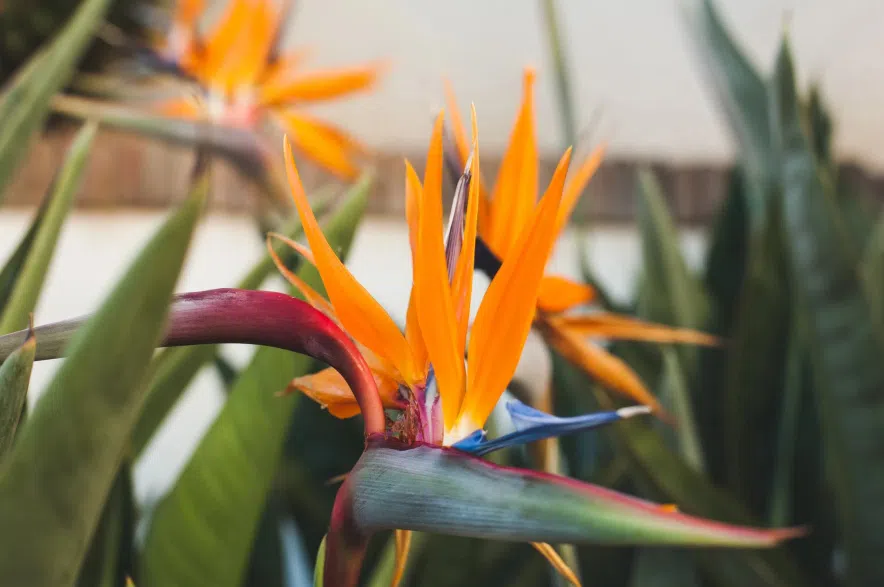Jill and Rick Van Duyvendyk answer all your gardening questions in Garden Talk on 650 CKOM and 980 CJME every Sunday morning.
Here are some questions and answers from the Feb. 23 show.
https://iono.fm/e/1530204
These questions and answers have been edited and condensed for clarity.
Q: How can I fix a large bird of paradise houseplant with fungus gnats? Diatomaceous earth, Safer’s soap, sticky strips and sparying diluting hydrogen peroxide has not worked.
A: It sounds like there’s some rotting or something happening in that root ball. Get a tarp or a blanket, tip your plant on its side and pull it out of the pot. Healthy roots will not fall apart if you brush them with your finger, if they are falling apart you’ve got root rot.
Clear out the dead, rotting roots and let it sit overnight, just out with an open root ball to allow it to breathe. Then re-pot the plant using new soil, and check your moisture with a meter. With larger tropical plants, sometimes we tend to water once a week with a cup of water and we’re only watering the first top inch of the soil but the bottom of the pot is actually saturated.
Check the moisture by sticking something down about six to eight inches into the pot and water thoroughly so that it drains through the bottom to get it evenly watered. Make sure you have holes in the bottom of your pot.
There is a great fertilizer called Root Rescue, which can help rejuvenate those roots and help get it going again. You can also try probiotics or Rage Plus. If you have a healthy plant, it’s able to combat things.
Q: My begonias have started sprouting. When should I pot them or can they be left in cold storage for a few more weeks?
A: You want to get them going right now, and sometimes as early as late January, early February. Don’t plant them too deep. The bulbs have what we call a hip on the top of it and then a bit of a divot. You want the hip just to be sticking slightly out of the soil.
Plant them into a pot that’s no more than two inches bigger in diameter than the bulb and if you’re putting multiple bulbs in a pot, make sure they’re not touching, and two fingers together on either side of the bulb and then that’s how much space should be.
If you have a pot that is too big, there’s too much moisture and the bulb will rot when you water it. Don’t overwater them. Put a bit of bone meal in a pot and plant it up, and give it some light and you’re gonna start getting some growth.
Q: How would an Eurasian pear fare in the sandy soil around Biggar?
A: It’ll be fine, it’s a very tough pear. It’s just a matter of making sure that you give it the nutrients it needs with compost and give it the water it needs. Dig the hole twice as wide as the root ball is and backfill it with some good with some good soil.
Q: My orchid is not blooming despite using the banana trick. Should I try and expose it to a banana again? Can I transplant it?
A: You can transplant it if you want to. Remember that orchids are air plants, their roots enjoy a lot of air, they enjoy to be dry, they enjoy to be misted, but they don’t like to be saturated. Healthy roots are kind of a silvery color, silvery whitish green color. If they look like they’re brown or sort of a yellowish color, gray, it means means that you’re overwatering.
Pulling the plant out of the pot will sometimes give it a little bit of transplant shock and get it to bloom again. Dunk the plant in a bucket of water until all the media comes loose. Trim off any ugly and gross roots and then replant it in an orchid bark media.
You might want to give it extra light with a grow light right now. Once we get into end of March or April when daylight hours are longer you might see it starting to get a flower spike or, try the banana trick again then.
If you transplant it put it in an orchid pot with bigger holes at the bottom. Don’t use a pot that doesn’t have very big holes because that’ll make it too moist. There are orchid pots with holes all the way around the edge.
When you water it, drown it. Fill the pot with water and let it sit for 20 minutes as the bark that it’s sitting around absorbs a bunch of water. Then pull it out and drain it, then leave it for three weeks to a month. Let it dry out completely before rewatering.
Read Dutch Growers Ultimate Guide to Seed Starting here.
Q: When do I plant Calibrachoa seeds?
A: Get them going right now. Once they get two sets of leaves on them, give them a little bit of a trim to top them and allow for branching. You can also grow them from cuttings.
Q: When should I start hot pepper seeds?
A: Right now, the third week of February is a good start date . Bell peppers don’t take as long. Use a dome or something over the seeds and watch for germination. Take the dome off as soon as you see those first two leaves come up or you will get too much humidity and heat in there and the plants will start stretching.
The best way to water those seeds is you use a mister and wet the soil rather than using a watering can, which can dislodge them.
Q: What other seeds should I start right now?
A: Pretty much all annuals you can start into March — coleus, dusty, miller, lobelia, pansies, petunias, verbena, celery, some of your Spanish onions, peppers, 100- to 90-day tomatoes.
Using a heat mat is important when you’re getting your seeds going, more so than your light. You need light as soon as you the leaves come out. Make sure the light is sitting six to eight inches above your plants.
You want high humidity when the seeds are germinating, but you want low humidity once the plants have already started to leaf out as well.
Germination rates can vary but site between 70 per cent and 100 per cent, so place one or two seeds per cell or hole. You can even take a paper towel and soak the seeds before planting to check they’re still viable if they have been stored a while.
Read more:











